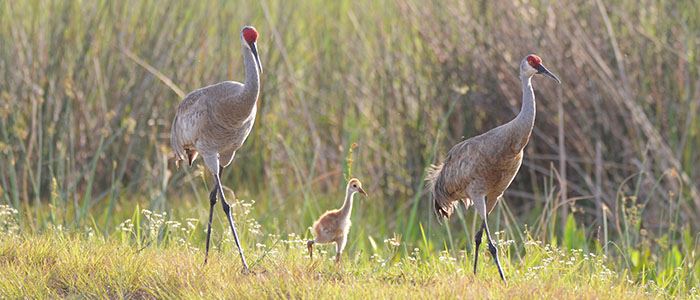Bringing Biodiversity Back Home

By Karen Menard
There is a saying, “If you build it, they will come.” Habitat restoration could be compared to choosing that ideal location for construction of a home itself.
Effectively restoring a habitat starts with acquiring a preferred tract of land then analyzing soil composition and water drainage; creating a site blueprint design; sourcing the best materials; and building a community that will attract and sustain species seeking a home.
The Nature Conservancy recently acquired an important 280-acre tract of land in the heart of the Oak Openings Region, where a unique habitat restoration project now underway. The property is a critical connection in the Oak Openings corridor where TNC, Metroparks and other partners in the Green Ribbon Initiative have focused their attention for many years.
With a goal of eventually providing an attractive wetland for breeding sandhill cranes, this project site consists of former agricultural land that had been drained, ditched and farmed for decades. It is currently in the process of being restored and re-vegetated to drastically aid in the reduction of sediment and nutrient run-off, keeping nearby waterways cleaner. The project will include changing the hydraulics of the site and creating topographic variation to restore habitat attracts both wetland and upland wildlife species, enhancing biodiversity in the region.
Native Plants Important
Sourcing and correctly planting the right plant communities is an important part of restorations like this one. That’s where Metroparks Blue Creek Nursery comes in.
The seed nursery is well-equipped with greenhouses, storage, seed processing equipment and plant propagation fields. It is the largest publicly-owned nursery in Ohio and produces native eco-type seed and plants for natural area restoration project. Native seed collected straight from the Oak Openings region is essential in the successful re-vegetation of new sites like the sandhill crane wetland.
The biodiversity of northwest Ohio has evolved with certain plant species and continues to rely on them. The plants themselves have adapted to particular local environmental conditions, too.
Metroparks helped by contributing or processing a total of 2,350 pounds of native seed for this project. The seed was collected by hand from wild populations and machine harvested from special, on-site propagation fields and larger, naturally occurring populations.
Two custom seed mixes were created for a grand total of 200 species—most specific to wet prairie habitats and the remaining 15 percent covering upland prairie. Habitats growing with unique Oak Openings species such as wiregrass (Carex lasiocarpa), twig-rush (Cladium mariscoides), Riddell’s goldenrod (Solidago riddellii) and Indian grass (Sorghastrum nutans) will serve as just a few of the many essential habitat components that will thrive to invite significant biodiversity back home to this restored Oak Openings community.
As the wetland sedges and grasses grow to build a viable wetland prairie community, the hope is that the sandhill cranes that once nested in the region and other wet prairie species seeking a home will return to this key site to nest and forage.